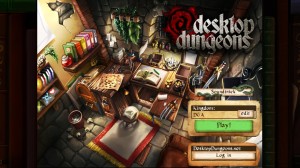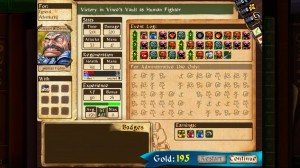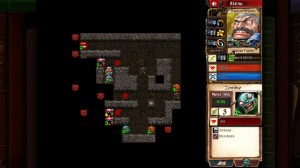Rougelikes have a reputation for being brutal, as one of their common features involves a permadeath system that prevents you from going back and loading a previous save when things go horribly wrong. “Desktop Dungeons” has all of the characteristics of a roguelike in that regard, but it does some pretty unique things that sets it apart from the rest of the crowd. Before we don our helmets and sharpen our swords, I’d like to quickly thank Danny Day from QCF Design for providing me with a free press copy.
Editor’s Note: Linux, iOS, and Android versions , at the time of this article’s posting, are currently in the works. You can also play the game on the official site, assuming you have a copy of the game and a supporting browser.
Before we touch on the nitty-gritty details, the big picture requires a little bit of explanation. You may have read somewhere, either on the Steam store page or the official site, that games can last as little as ten minutes long. This is partly true. You see, there is a quote unquote “overworld” which houses your kingdom. It’s from here that you can send your disposable adventurers into the depths. So while a particular dungeon might only take ten minutes of your time to complete, you’ll be using the loot and funds you acquire from said dungeon run to upgrade your kingdom.
Speaking of which, you’ll be using gold to upgrade your buildings and unlock new stuff, for the most part. Your kingdom’s bank is limited to 400 gold pieces to start, but you can upgrade it to hold more down the line. Upgrading buildings will provide you with new races, classes, monsters, and preparations. The blacksmith building, for example, lets you purchase weapons and armor to prep your adventurer for their run. Class buildings allow you to unlock new tiers of the related class…for example, you’ll start with a fighter via the guild building, but be allowed to upgrade him (or her) to a berserker and then a warlord. Upgrading your kingdom will provide you with new and exciting things to try out and is at the very heart of what your goal will ultimately be.
Unlike an RPG, your adventurer will always begin at “level one” at the start of a dungeon run. Your goal will be to level up (granting you an increase to your base stats) and kill the boss monster(s) in said dungeon. Clicking another monster initiates a combat exchange, while spells have special rules of their own for the player to consider. If I were to stress anything however, I’d be negligent not to mention that your adventurer heals automatically only when they are exploring a new part of the dungeon (or fog of war). This turns exploration into a strategic resource of sorts, as you’ll want to save some of that unknown dungeon for healing later on. Of course, you can use potions and the like in a pinch, though I found them to be most useful during a boss fight. Leveling up also restores you to full strength, so you can play strategically in that regard by saving lower level monsters for when you need refreshed during tougher battles.
I was very surprised to see religion play a part in “Desktop Dungeons”. Gods each have their own behaviors and reward or penalize the player based on the action taken during their run. Get on a god’s good side and you can earn some piety, which can be used to purchase boons. Gods can be unlocked by completing their appropriate dungeon and alters automatically spawn in your runs as they become unlocked. You can even desecrate an alter in extreme situations, though that usually has some type of detrimental effect. I didn’t think I’d like the religion mechanic at first, but it grew on me and forced me to make decisions that I wouldn’t normally make.
In terms of complexity, the game has a casual theme yet has a fair amount of depth to it. There’s an entire Wiki page devoted to combat alone, and there are even tips there to help players figure out how to make the most of their dungeon run. Combat does require a little bit of mental math, as you’ll need to calculate how much damage you can do in the long run before the monster knocks you off altogether. Thankfully, the game does tell you the results of your next hit when you hover over an enemy. Besides combat, there are a lot of little behind the scene stats to consider. Every race or class in the game has some sort of unique play style and character sheet for example, allowing you to mix and match and experiment in order to find a great combination. I was admittedly overwhelmed at first by all the rules and stats, but it’s a learning curve that made the game fun in the process.
“Desktop Dungeons” prides itself on being the perfect coffee-break game, and I’m forced to agree. It’s very easy to plop into the game, get through a dungeon or two, and still feel like you accomplished something. The fact that the dungeons randomly generate improve upon the replayability tenfold, and that’s not counting the depth and numbers behind some of the game’s more complex concepts. The simple two-dimensional dungeon view might seem archaic to some, but I found that it went a long way into preventing sensory overload. I was too busy running numbers in my head and planning out my moves, anyway. From a parental standpoint, I’d say that the game is appropriate for ages 16+, as there is some inappropriate language and gore. Along those same lines, this is a perfect game for someone like me who is always pulled away due to work or some sort of parental obligation.
As such, “Desktop Dungeons” is, without a doubt, a masterpiece that everyone should try at least once. There’s a unique puzzle element about it that makes me think about how I should best proceed based on my current circumstances. It’s also casual yet not, the perfect recipe for a rougelike game (in my opinion). All in all, a brilliant game!
Final Verdict: 9/10
—
http://store.steampowered.com/app/226620/
http://www.desktopdungeons.net/
—
http://www.youtube.com/watch?v=AGVR6L_C384



